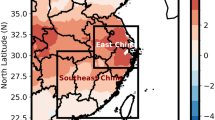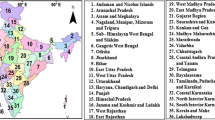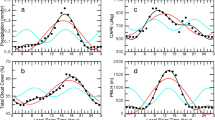Abstract
To satisfy the requirement of surface energy budget research on the meso- and micro-scale, a parameterization is developed to calculate high spatial resolution, clear-sky downward longwave radiation (DLR) from HJ-1B thermal data. The DLR algorithm is established based on extensive radiative transfer simulation and statistical analysis. To address the problem that HJ-1B has a single thermal channel and lacks atmospheric information, the brightness temperature of HJ-1B and water vapor content are used in the algorithm. An accuracy evaluation and error analysis for the algorithm is conducted using a simulated radiation dataset. The result shows that the algorithm performs well in most circumstances, but there is obvious underestimation when water vapor content is greater than 4 g/cm2. Error analysis indicates the accuracy of estimated DLRs is affected by uncertainties in input parameters, including water vapor content and top-of-atmosphere radiance. It is also affected by the difference between ground and near-surface air temperature. The algorithm is applied to actual HJ-1B data, and validated by ground data from six stations in the Heihe River and Haihe River basins. The estimated DLRs have good consistency with measured data except at Huazhaizi, and root mean square errors at most sites are around 20 W/m2, which is slightly better than the result of MODIS. There is significant overestimation of DLR at Huazhaizi during summer, which is mainly produced by the large ground-air temperature difference. A correction process based on temperature difference is proposed and applied at Huazhaizi. The result shows that the positive bias is largely diminished after correction.
Similar content being viewed by others
References
Schmetz P, Schmetz J, Raschke E. Estimation of daytime downward longwave radiation at the surface from satellite and grid point data. Theor Appl Climatol, 1986, 37: 136–149
Idso S B. A set of equations for full spectrum and 8- to 14-mm and 10.5- to 12.5-mm thermal radiation from cloudlessskies. Water Resour Res, 1981, 17: 295–304
Crawford T M, Duchon C E. An improved parameterization for estimating effective atmospheric emissivity for use in calculating daytime downwelling longwave radiation. J Appl Meteorol, 1999, 38: 474–480
Niemelä S, Raisanen P, Savijärvi H. Comparison of surface radiative flux parameterizations: Part I: Longwave radiation. Atmos Res, 2001, 58: 1–18
Iziomon M G., Mayer H, Matzarakis A. Downward atmospheric longwave irradiance under clear and cloudy skies: Measurement and parameterization. J Atmos Sol-Terr Phys, 2003, 65: 1107–1116
Dupont J C, Haeffelin M, Philippe D, et al. Parametric model to estimate clear-sky longwave irradiance at the surface on the basis of vertical distribution of humidity and temperature. J Geophys Res, 2007, 113: D07203
Nadiane S K, Íria F V. Downward longwave radiation estimates for clear and all-sky conditions in the Sertãozinho region of São Paulo, Brazil. Theor Appl Climatol, 2009, 99: 115–123
Tuzet A. A simple method for estimating downward longwave radiation from surface and satellite data by clear sky. Int J Remote Sens, 1990, 11: 125–131
Gupta S K. A Parameterization for longwave surface radiation from sun-synchronous satellite data. J Clim, 1989, 2: 305–320
Gupta S K, Darnell W L, Wilber A C. A parameterization for long-wave surface radiation from satellite data-recent improvements. J Appl Meteorol, 1992, 31: 1361–1367
Gupta S K, Kratz D P, Wilber A C, et al. Validation of parameterized algorithms used to derive TRMM-CERES surface radiative fluxes. J Atmos Ocean Tech, 2004, 21: 742–752
Gupta S K, Kratz D P, Stackhouse J, et al. Improvement of Surface Longwave Flux Algorithms Used in CERES Processing. J Appl Meteorol Clim, 2010, 49: 1579–1589
Inamdar A K, Ramanathan V. On monitoring the atmospheric greenhouse effect from space. Tellus B, 1997, 49: 216–230
Zhou Y P, Cess R D. Algorithm development strategies for retrieving the downwelling longwave flux at the Earth’s surface. J Geophys Res, 2001, 106: D12
Zhou Y P, Kratz D P, Wilber A C, et al. An improved algorithm for retrieving surface downwelling longwave radiation from satellite measurements. J Geophys Res, 2007, 112: D15
Morcrette J J, Deschamps P Y. Downward longwave radiation at the surface in clear sky atmospheres: Comparison of measured, satellite-derived and calculated fluxes. Proc ISLSCP Conf, Rome, Italy, ESA SP-248, 1986. 257–261
Smith W L, Woolf H M. Geostationary satellite sounder (VAS) observations of longwave radiation flux. Paper presented at the Satellite Systems to Measure Radiation Budget Parameters and Climate Change Signals. Iglis, Austria, International Radiation Commission, 1983
Lee H T, Ellingson R G. Development of a nonlinear statistical method for estimating the downward longwave radiation at the surface from satellite observations. J Atmos Ocean Technol, 2002, 19: 1500–1515
Tang B H, Li Z L. Estimation of instantaneous net surface longwave radiation from MODIS cloud-free data. Remote Sens Environ, 2008, 112: 3482–3492
Wang W H, Liang S L. Estimation of high-spatial resolution clear-sky longwave downward and net radiation over land surfaces from MODIS data. Remote Sens Environ, 2009, 113: 745–754
Zhang Y C, Rossow W B, Lacis A A, et al. Calculation of radiative fluxes from the surface to top of atmosphere based on ISCCP and other global data sets: Refinements of the radiative transfer model and the input data. J Geophys Res, 2004, 109: D19015
Fu Q, Liou K N, Cribb M C, et al. Multiple scattering parameterization in thermal infrared radiative transfer. J Atmos Sci, 1997, 54: 2799–2812
Gui S, Liang S L, Li L. Evaluation of satellite-estimated surface longwave radiation using ground-based observations. J Geophy Res, 2010, 115: D18214
Yang K, Koike T, Stackhouse P, et al. An assessment of satellite surface radiation products for highlands with Tibet instrumental data. Geophys Res Lett, 2006, 33: L22403
Viu’dez-Mora A, Calbo J, González J A, et al. Modeling atmospheric longwave radiation at the surface under cloudless skies. J Geophy Res, 2009, 114: D18107
Galve J M, Coll C, Caselles V, et al. An atmospheric radiosounding database for generating land surface temperature algorithms. IEEE Trans Geosci Remote Sensing, 2008, 46: 1547–1557
Li H. The study of algorithms for land surface temperature retrieval from HJ-1B/IRS and FY-3A/MERSI data (in Chinese). Dissertation for the Doctoral Degree. Beijing: Institute of Remote Sensing Applications, Chinese Academy of Sciences, 2010. 59–65
Qi S H, Wang J B, Zhang Q Y, et al. Study on the estimation of air temperature from MODIS data (in Chinese). J Remote Sens, 2005, 9: 570–575
Zhu S Y, Zhang G X. Progress in near surface air temperature retrieved by remote sensing technology (in Chinese). Adv Earth Sci, 2011, 26: 724–730
Li X, Li X W, Li Z Y, et al. Watershed allied telemetry experimental research. J Geophy Res, 2009, 114: D22103
Huang G H, Zhang Z H, Tan J L, et al. User’s guide for meteorological, hydrologic and data (in Chinese). Technical Report, Cold and Arid Regions Environmental and Engineering Research Institute, Chinese Academy of Sciences, 2010
Harold R L. Algorithm theoretical basis document for ASTER DIGITAL ELEVATION MODELS, Version 3, 1999
Yu S S, Xin X Z, Liu Q H. Estimation of clear-sky download longwave radiation from satellite in Heihe River Basin of Northwest China. 2011 IEEE International Geoscience Remote Sensing Symposium. Vancouver, Canada, 2011 July 24–29, 269–272
Li J G, Gu X F, Li X Y, et al. Validation of HJ-1 B thermal band on-board calibration and its sensitivity analysis (in Chinese). Remote Sensing Inf, 2011, 1: 3–8
Gao B C, Kaufman Y J. Water vapor retrievals using moderate resolution Imaging spectroradiometer (MODIS) near-infrared channels. J Geophys Res, 2002, 108: 4389
Meng X H, Lu S H, Zhang T T. Testing, improvement and application of MODIS near infrared water vapor product—Taking Jinta oasis in the Hiehe River Basin as a case study (in Chinese). J Infrared Millimeter Waves, 2007, 26: 107–111
Author information
Authors and Affiliations
Corresponding author
Rights and permissions
About this article
Cite this article
Yu, S., Xin, X. & Liu, Q. Estimation of clear-sky longwave downward radiation from HJ-1B thermal data. Sci. China Earth Sci. 56, 829–842 (2013). https://doi.org/10.1007/s11430-012-4507-z
Received:
Accepted:
Published:
Issue Date:
DOI: https://doi.org/10.1007/s11430-012-4507-z




